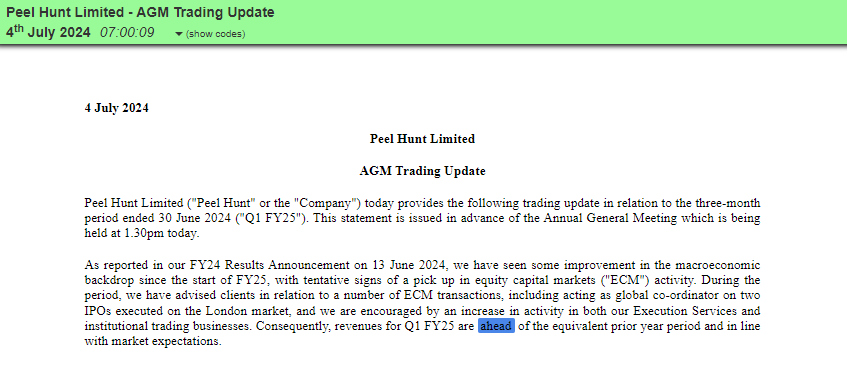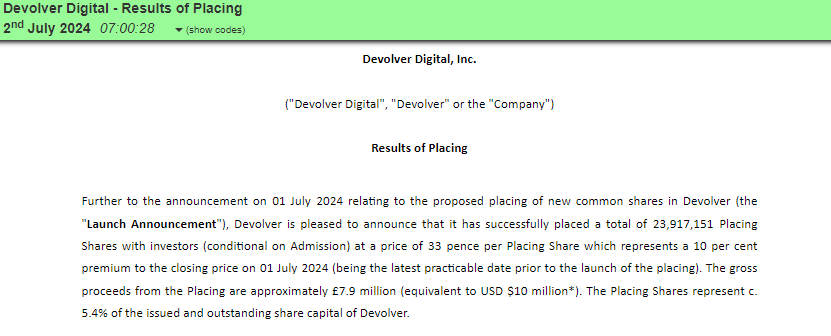In this article Michael looks at share placings and how to take advantage of them.

Equity placements, also known as share placings, are a critical aspect of the financial markets. They are what you might call a necessary evil and are often used by companies to raise capital.
That said, not all share placings are bad. It’s become fashionable to blame investor sentiment as the reason for why a company is delisting. I would counter those arguments by suggesting that great companies are having no issue raising money. If you’re an illiquid, unprofitable, cash-burning pharmaceutical company, that is years down the line from profitability and struggling to raise money, then the reason may be because you’re an illiquid, unprofitable, cash-burning pharmaceutical company, that is years down the line from profitability.
However, there are problems in the UK stock market that need fixing. And investor appetite has dampened down somewhat. In a sustained downtrend, that will always happen.
But Peel Hunt mentioned this week that there have been “tentative signs of a pick up in equity capital markets”. I think it’s worth looking at placings as they are likely to increase as markets grind higher.

What are equity placements?
Equity placements involve issuing new shares to investors. These are almost always done at a discount to the current market price.
Sometimes they are done at a premium like at Devolver Digital.

This is rare though, and a premium placing should be questioned. Why would investors put money in above the existing market price? Maybe they want to protect their investment in the company already and limit dilution. Or, in the junior mining end of the market, maybe it’s a scam.
Raising money is often done by companies for various reasons including growth and expansion (a sensible use of funds), debt reduction (strengthens the balance sheet), or other corporate activities such as buying another company.
Raising money to buy a company that will be earnings accretive is likely to be more attractive than a junior mining company raising money to do a bit of drilling (and pay the director’s salaries of course).
How traders can take advantage of equity placements
Placings can offer an entry into a stock at a discounted price. The problem here is that if it’s an extremely attractive placing, you will find you often get scaled back, or the plum deals are simply not offered to private investors.
Usually, the price will trade towards the placing price because there will be places (people who took the placing) happy to flip the stock for a quick profit. This causes an overhang in the stock whilst those early profit takers sell their shares.
Source: The UK Stock Trading Course
In a frothy bull market, these overhangs are less and are eaten through quicker because of the sentiment.
In a bear market, placings will often fall to and even below the placing price.
To get access to fundraises you would need to sign up to a broker that offers these to its clients. These brokers will typically charge a higher commission than an execution-only (XO) broker because of the nature of the business. I’ve created a walkthrough video on stockbrokers here.
However, a better way to use placings is to either avoid stocks that will likely need to raise capital or even short them.
How to spot upcoming equity placements
Steering clear of upcoming share placements is a great way to avoid taking big losses. Some companies raise at a slight discount, and as mentioned a small few at a premium, but most of these are at moderate discounts to the prevailing price as new investors demand their pound of flesh.
Identifying potential equity placements before they are announced can give investors a strategic advantage.
Work back the cash
One method you can use is to work back the cash.
First of all, you’ll need to check both the balance sheet and the cash flow statement of operations.
Go to the balance sheet and under ‘current assets’ look at the company’s cash position.
Remember, the balance sheet is at a specific point in time and so this is only true at the stated date.
This is why we then need to go through the cash flow statement in order to get an idea of the cash movements in the business.
Look at cash flow generated/burned through operations. If this number is negative, then you know the company has burned through cash.
Now you need to take this number and divide it by the appropriate period to get burn per month. If it’s interim results then it’ll be six months, and if it’s full year then it’s 12.
From that point, you can now work back the company’s cash position to get a rough idea of the company’s current cash position. If it’s going to run out of cash within six months then it’s an instant avoid.
Personally, I prefer companies that have at least 12 months’ worth of cash to mitigate any dilution risk. When there are nearly 2,000 companies on the London Stock Exchange – why buy a crock that might sting you with a discounted share placing?
Joint broker announcement
Joint broker appointments announced through the RNS have an uncanny correlation with an upcoming placing.
Director Commentary
Director commentary can sometimes be useful as any reference to a ‘second half weighting’ could mean a profit warning on the way. And if the balance sheet is precarious or propped up by intangibles, that could signal a cash call on the way.
Conclusion
Equity placements are a vital tool for companies seeking to raise capital. Good companies will be able to raise more money and closer to the market price, whereas companies that are reliant on cash injections to keep the lights on will always struggle unless they can come up with a hugely exciting story that captivates investors.
Make sure you’re always aware of a company’s liquidity before you take a trade or invest, and this will help you avoid getting stung by discounted placings.
~
Michael Taylor
Buy The Bull Market free and premium trading newsletter available at: newsletter.buythebullmarket.com
Twitter: @shiftingshares
Got some thoughts on this week’s article from Michael? Share these in the SharePad chat. Login to SharePad – click on the chat icon in the top right – select or search for a specific share or the “Traders chat”
This article is for educational purposes only. It is not a recommendation to buy or sell shares or other investments. Do your own research before buying or selling any investment or seek professional financial advice.




